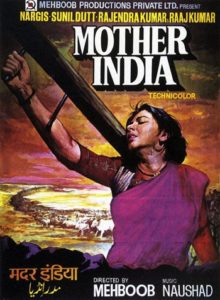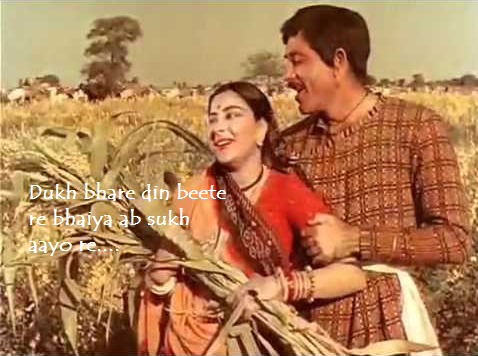Raaga Based Song of the Day: Dukh bhare din beete re bhaiya…
Raag Megh Malhar, Tal Dadra
A song in Raag Malhar is by a special request by a dear friend who learnt classical music whilst he was in school and unlike most of us, he retains in his mind substantial parts of that learning more than fifty years ago. His favourite Raaga is Malkauns but he has asked for a song in this raaga because of onset of monsoons.
The only thing that my dear friend Viru (short for Virendra Singh) didn’t tell me was which Malhar he wanted it in. Hence, I chose independently and chose Megh Malhar. I hope he approves of it.
Monsoon rains mean the world to us Indians. How well our economy does is still related to the success of monsoons. Hindi film directors, therefore, depicted rains as the end of miserable conditions that exist for our common folk prior to them, especially for farmers.
We have completed nineteen days of Raaga Based Songs of the Day. Our first post in the series was titled ‘Raaga Based Song Of The Day #1’ and the song was a Mohammad Rafi and Lata Mangeshkar song from the 1970 Shakti Samanta movie Pagla Kahin Ka: Tum mujhe youn bhula na paoge. It is in Raag Jhinjhoti, Tal Kaherava.
Our nineteenth post or the last post was titled ‘Raaga Based Song Of The Day #19’ and the song was a Lata Mangeshkar song from the 1962 Amar Kumar movie Rungoli: Jao jao Nand ke lala. It is in Raag Bageshri, Tal Tintal.
This blog has a number of posts on Raaga based songs in Hindi movies titled similarly; for example: ‘The Best Raaga Based Songs in Hindi Movies – Raaga Todi’.
Indians usher in the rainy season with Raag Malhar. During the olden days, rendition of Raagas would evoke results associated with the theme or the mood of the raaga. For example, Mian Tansen, as one of the Navratnas in the court of Emperor Akbar, could light up candles with the rendition of Raag Deepak. He could bring in rains with the rendition of Malhar and so on.
Malhar is rendered in its pure (Shuddha) form. And then there are many other variations of Malhar such as Mian Ki Malhar (Mian Tansen was such a phenomenal composer that his style of composing a raaga had his own stamp or signature over the raaga; such as Mian Ki Malhar, Mian Ki Todi, and Mian Ki Sarang). In addition, you would recall that he was the original composer of Raag Darbari Kanada that he was reputed to have brought into Hindustani music from the South (Carnatic Music), Meera Ki Malhar, Nat Malhar, Ramdasi Malhar, Gaud Malhar, Sur Malhar, Des Malhar and Megh Malhar.
As far as earliest known forms of Malhar are concerned, Shuddha, Gaud and Megh Malhar are the oldest (much before Tansen in the 16th century). Hence, whilst choosing this song in Megh Malhar, I have chosen for you one of the oldest variations of Malhar.
Raag Malhar is also a Raag of the Kafi Thaat. Its Jati is Audhav-Audhav, that is, it is a pentatonic (five notes) raaga both in aaroha and avroha (the varjya notes are Gandhar (Ga) and Dhaivat (Dha); Nishad (Ni) is komal. Rest all are Shuddha swaras. The time for playing this raaga is any time during the rainy season.
The other raagas of the Kafi Thaat are Dhanashri, Dhani, Bhimpalasi, Pilu, Megh Malhar, and Bageshri. Kafi Thaat, of course, takes its name from Kafi Raaga. It is not such a Pracheen ((ancient) Raaga, having originated soemtime in the 15th century. The best part of the Raaga is that it is so folksy rather than purely classical (naturally, as you listen to Malhar, one is reminded of average folks on the street rather than in cloistered palaces etc). Hence, one would rather hear Tappa, Hori, Dadra, Bhajans and Kirtan in this Thaat than serious classical raaga renditions). One can easily call Kafi Raaga as People’s Raaga.
 I have taken this song for you from the 1957 Mehboob Khan’s iconic movie Mother India that nearly won an Oscar. The best pairing ever in Hindi movies of a lyricist with music director, that is Shakeel Badayuni with Naushad Ali (the former had a hat-trick of Filmfare Awards from 1961 to 63 and the latter was the recipeint of the highest award in cinema: the Dadasaheb Phalke Award) (Please also go through: ‘The Best Of Old Hindi Songs – Rafi, Shakeel, Naushad and Dilip Kumar Together’) made this song. It was sung by Shamshad Begum, Mohammed Rafi, Manna Dey, and Asha Bhosle.
I have taken this song for you from the 1957 Mehboob Khan’s iconic movie Mother India that nearly won an Oscar. The best pairing ever in Hindi movies of a lyricist with music director, that is Shakeel Badayuni with Naushad Ali (the former had a hat-trick of Filmfare Awards from 1961 to 63 and the latter was the recipeint of the highest award in cinema: the Dadasaheb Phalke Award) (Please also go through: ‘The Best Of Old Hindi Songs – Rafi, Shakeel, Naushad and Dilip Kumar Together’) made this song. It was sung by Shamshad Begum, Mohammed Rafi, Manna Dey, and Asha Bhosle.
Please enjoy: Dukh bhare din beete re bhaiya, ab sukh aayo re….
(duHkh bhare din biite re bhaiyaa ab sukh aayo re
ra.ng jiivan me.n nayaa laayo re) -2
hoy hoy duHkh bhare din biite re bhaiyaa, biite re bhaiyaa
dekh re ghaTaa ghirake aa_ii ras bhar-bhar laa_ii -2
o ghaTaa ghirake aa_ii, ho
chhe.D le gorii man kii biinaa rimajhim rut chhaa_ii -2
o ghaTaa ghirake aa_ii
prem kii gaagar laa_e re baadar bekal moraa jiyaa hoy -2
duHkh bhare din biite re bhaiyaa …
madhur-madhur manavaa gaa_e apane bhii din aa_e -2
o madhur manavaa gaa_e, ho
saavan ke sa.ng aa_e javaanii saavan ke sa.ng jaa_e, o -2
o madhur manavaa gaaye, ho
aaj to jii bhar naach le paagal kal na jaane re kyaa hoye -2
duHkh bhare din biite re bhaiyaa
We have intended to learn about Raaga based music whilst we entertain ourselves with Raaga based songs. So, lets, once again, take stock of our collective learning so far:
- On the first day we learnt about the Raaga system devised by Pandit Vishnu Narayan Bhatkhande, which is the prevalent system in Hindustani Classical Music and based on ten Thaats.
- On the second day we learnt about Tal or Taal.
- On the third day we learnt about characteristics of Raagas that included Swar, Jati, Thaat, Arohana and Avarohana, Vadi, Samvadi and Pakad.
- On the fourth day, we learnt about Sargam.
- On the fifth day, we learnt about notations used in Indian classical music or simply Swar Lipi.
- On the sixth day, we learnt about the Ras (sentiments) that Raagas evoke.
- On the seventh day, we learnt about various types of Swar: Shuddha, Achal, Vikrut, Komal and Teevra.
- On the eighth day, we learnt the parts of a composition in Indian Classical Music.
- On the ninth day, we learnt the names of some of the popular instruments used in Indian Classical Music.
- On the tenth day, we learnt about the sources of names of Raagas.
- On the eleventh day, we learnt about why Bhairavi is the first raag to be taught to beginners and also why it is the last in a performance.
- On the twelfth day, we learnt about Khammaj Thaat.
- On the thirteenth day, we learnt about Tal Punjabi Theka or Sitarkhani.
- On the fourteenth day, we learnt about Alap.
- On the fifteenth day, we learnt about List of Raagas (Raagmala) in my favourite book: Sri Guru Granth Sahib.
- On the sixteenth day, we learnt about tips for raaga identification.
- On the seventeenth day, we learnt the basics of Gharana system.
- On the eighteenth day, we learnt about Filmi Sangeet.
- On the nineteenth day, we learnt about the commonest Tal in Raagas: Tintal.
- And today, on the twentieth day, we learnt about the Kafi Thaat.
There is much more still to be learnt and enjoyed.
Please stay tuned!

Keep sending.